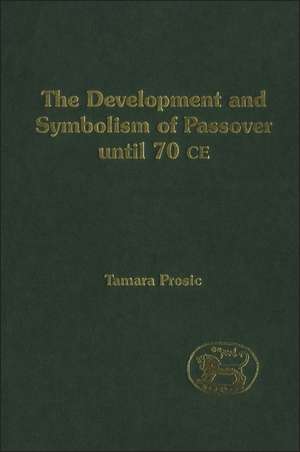The Development and Symbolism of Passover: The Library of Hebrew Bible/Old Testament Studies
Autor Tamara Prosicen Limba Engleză Hardback – 27 noi 2004
Din seria The Library of Hebrew Bible/Old Testament Studies
- 30%
 Preț: 599.90 lei
Preț: 599.90 lei -
 Preț: 159.16 lei
Preț: 159.16 lei - 30%
 Preț: 541.20 lei
Preț: 541.20 lei - 23%
 Preț: 192.01 lei
Preț: 192.01 lei -
 Preț: 99.40 lei
Preț: 99.40 lei - 30%
 Preț: 509.52 lei
Preț: 509.52 lei - 23%
 Preț: 192.36 lei
Preț: 192.36 lei - 30%
 Preț: 509.93 lei
Preț: 509.93 lei -
 Preț: 168.53 lei
Preț: 168.53 lei -
 Preț: 168.75 lei
Preț: 168.75 lei - 30%
 Preț: 655.82 lei
Preț: 655.82 lei - 22%
 Preț: 568.27 lei
Preț: 568.27 lei - 23%
 Preț: 190.50 lei
Preț: 190.50 lei -
 Preț: 472.27 lei
Preț: 472.27 lei - 30%
 Preț: 665.45 lei
Preț: 665.45 lei - 23%
 Preț: 193.80 lei
Preț: 193.80 lei - 30%
 Preț: 656.06 lei
Preț: 656.06 lei - 30%
 Preț: 538.77 lei
Preț: 538.77 lei - 24%
 Preț: 508.76 lei
Preț: 508.76 lei -
 Preț: 168.75 lei
Preț: 168.75 lei -
 Preț: 472.22 lei
Preț: 472.22 lei -
 Preț: 172.88 lei
Preț: 172.88 lei - 30%
 Preț: 510.04 lei
Preț: 510.04 lei - 30%
 Preț: 893.55 lei
Preț: 893.55 lei - 30%
 Preț: 508.44 lei
Preț: 508.44 lei - 30%
 Preț: 598.02 lei
Preț: 598.02 lei - 30%
 Preț: 774.62 lei
Preț: 774.62 lei - 30%
 Preț: 509.52 lei
Preț: 509.52 lei -
 Preț: 470.74 lei
Preț: 470.74 lei -
 Preț: 170.01 lei
Preț: 170.01 lei - 30%
 Preț: 714.35 lei
Preț: 714.35 lei - 30%
 Preț: 773.71 lei
Preț: 773.71 lei - 27%
 Preț: 1122.64 lei
Preț: 1122.64 lei - 22%
 Preț: 1122.47 lei
Preț: 1122.47 lei - 22%
 Preț: 1125.50 lei
Preț: 1125.50 lei - 22%
 Preț: 1066.87 lei
Preț: 1066.87 lei - 22%
 Preț: 1121.17 lei
Preț: 1121.17 lei - 22%
 Preț: 1005.18 lei
Preț: 1005.18 lei - 22%
 Preț: 1123.94 lei
Preț: 1123.94 lei - 22%
 Preț: 1131.53 lei
Preț: 1131.53 lei - 22%
 Preț: 768.98 lei
Preț: 768.98 lei - 22%
 Preț: 1120.52 lei
Preț: 1120.52 lei - 22%
 Preț: 827.69 lei
Preț: 827.69 lei - 22%
 Preț: 889.49 lei
Preț: 889.49 lei - 30%
 Preț: 714.27 lei
Preț: 714.27 lei - 22%
 Preț: 1128.93 lei
Preț: 1128.93 lei - 22%
 Preț: 1125.82 lei
Preț: 1125.82 lei - 22%
 Preț: 1064.75 lei
Preț: 1064.75 lei - 22%
 Preț: 893.15 lei
Preț: 893.15 lei - 18%
 Preț: 384.21 lei
Preț: 384.21 lei
Preț: 1063.21 lei
Preț vechi: 1236.29 lei
-14% Nou
Puncte Express: 1595
Preț estimativ în valută:
203.46€ • 211.13$ • 170.06£
203.46€ • 211.13$ • 170.06£
Carte tipărită la comandă
Livrare economică 15-29 martie
Preluare comenzi: 021 569.72.76
Specificații
ISBN-13: 9780826470874
ISBN-10: 0826470874
Pagini: 156
Dimensiuni: 156 x 234 x 14 mm
Greutate: 0.36 kg
Editura: Bloomsbury Publishing
Colecția Sheffield Academic Press
Seria The Library of Hebrew Bible/Old Testament Studies
Locul publicării:London, United Kingdom
ISBN-10: 0826470874
Pagini: 156
Dimensiuni: 156 x 234 x 14 mm
Greutate: 0.36 kg
Editura: Bloomsbury Publishing
Colecția Sheffield Academic Press
Seria The Library of Hebrew Bible/Old Testament Studies
Locul publicării:London, United Kingdom
Recenzii
Review ~ International Review of Biblical Studies, vol 51, 2004/05
' Tamara Prosic, whose University if Melbourne PhD dissertation is the basis for this book, agrees with Segal in asserting the essential unity of the festival against those who maintain its dual origin. It was the centralization of the cult that led to 'a distrubacen of the festival's spatial organization and coherence'. Builiding on this unitary view of the festival's origin, and adopting a structualist reading of the relevant texts, the author explores the symbolic meaning of this ancient festival that is still so much alive in contemporary Judaism and Christianity.'
' Tamara Prosic, whose University if Melbourne PhD dissertation is the basis for this book, agrees with Segal in asserting the essential unity of the festival against those who maintain its dual origin. It was the centralization of the cult that led to 'a distrubacen of the festival's spatial organization and coherence'. Builiding on this unitary view of the festival's origin, and adopting a structualist reading of the relevant texts, the author explores the symbolic meaning of this ancient festival that is still so much alive in contemporary Judaism and Christianity.'









